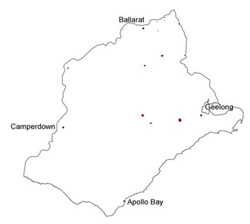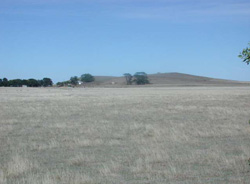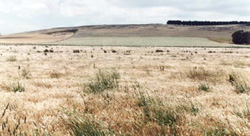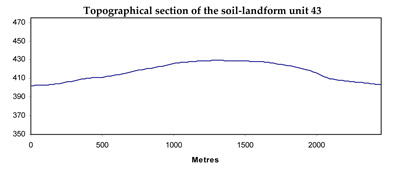Soil/Landform Unit 43
Landform Unit Description
Page top
 The moderately inclined low cone of Mount Moriac |
0.10% of CMA region The inclined low cones of Mount Hesse, Mount Moriac, Mount Wallace and Clever Hill form part of sequence of volcanic landforms within the Midlands of the Western Uplands, and the dissected plains of the Western Plains. These cones are characterised by cone crests and upper, mid or lower slopes. The cones support the vegetation classes plains Grassy Woodland and Herb-rich Foothill Forest. The upper slopes and crests, and the mid slopes support shallow red friable texture contrast and/or gradational soils, while the lower slopes host black self-mulching clays. The land use is mainly beef cattle and sheep grazing and cropping (particularly on the lower slopes). Erosion hazards are minimal. Areas with shallow stony gradational soils are susceptible to leaching of nutrients, and compaction is a problem on the lower slopes and depressions. |  |
 Mount Mercer |  |
|  Mount Hesse |
Component | 1 | 2 | 3 |
Proportion of soil-landform unit | 25% | 30% | 45% |
| CLIMATE Rainfall (mm) | Annual: 700 | ||
| Temperature (oC) | Minimum 8, Maximum 18 | ||
| Precipitation less than potential evapotranspiration | October-March | ||
| GEOLOGY Age and lithology | Quaternary basalt and scoria | ||
| Geomorphology | |||
| LANDUSE | Uncleared: Nature conservation; passive and active recreation; water supply; hardwood forestry Cleared: Beef cattle and sheep grazing; cropping; residential development; horticulture | ||
| TOPOGRAPHY Landscape | Moderately inclined low cones | ||
| Elevation range (m) | 104-690 | ||
| Local relief (m) | 40-50 | ||
| Drainage pattern | Dendritic | ||
| Drainage density (km/km2) | 0.4 | ||
| Landform | Volcanic cone | ||
| Landform element | Broad crest and gentle upper slopes | Steep mid and upper slopes | Lower slopes |
| Slope and range (%) | 3 (1-7) | 6 (3-15) | 3 (1-8) |
| Slope shape | Convex | Concave-Convex | Concave |
| NATIVE VEGETATION Ecological Vegetation Class | Plains Grassy Woodland (0.9%), Herb-rich Foothill Forest (0.7%) | ||
| SOIL Parent material | In situ basalt and scoria | In situ basalt and scoria | In situ basalt and scoria |
| Description (Corangamite Soil Group) | Shallo black self-mulching soils (39) | ||
| Soil type sites | SW102, SW101, SW103 | ||
| Surface texture | Loams | Loams | Clays |
| Permeability | High | High | Very Low |
| Depth (m) | <0.7 | <1 | <1 |
| LAND CHARACTERISTICS, POTENTIAL AND LIMITATIONS | Texture contrast soil with low water holding capacity, moderate nutrient holding capacity in upper soil, high in subsoil. Gradational soils, low to moderate water holding capacity, moderate to high nurtient holding capacity. Shallow to moderately rapid site drainage with slight susceptibility to sheet erosion. | Texture contrast soil with low water holding capacity, moderate nutrient holding capacity in upp soil, high in subsoil. Gradational soils, low to moderate water holding capacity, moderate to high nutrient holding capacity. Shallow to moderate deep, friable soils that are often stony. Rapid site drainage with slight susceptibility to sheet erosion. | Uniform expansive clay soils, high water holding capacity, very high nutrient holding capacity. Shallow to moderate deep, friable and self-mulching soils that are often stony. Moderate site drainage with slight susceptibility to rill erosion. |



